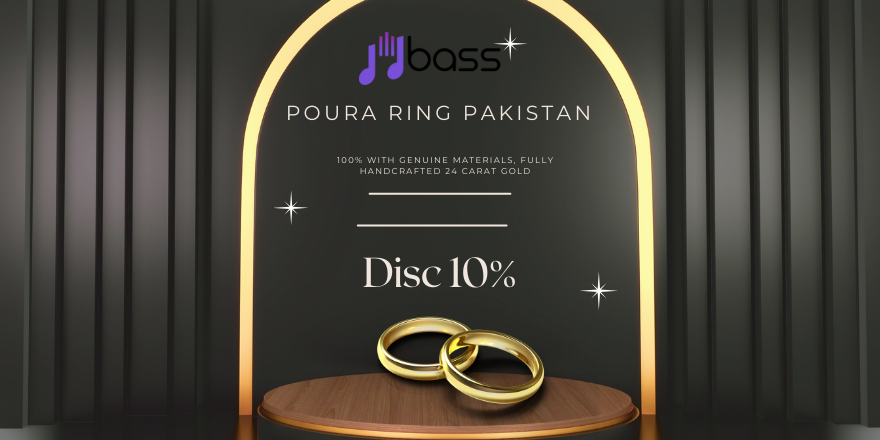In the realm of traditional jewelry, Poura Ring Pakistan boasts a rich heritage that is deeply rooted in cultural significance and exquisite craftsmanship. Among the myriad of ornamental treasures, Poura rings stand out as iconic symbols of Pakistani heritage and craftsmanship. These rings, with their intricate designs and historical significance, epitomize the fusion of artistry and cultural heritage.
Understanding the Origins of Poura Rings
To truly appreciate the beauty and significance of Poura rings, it’s essential to delve into their origins. Poura Ring Pakistan have a long and storied history in Pakistan, dating back centuries. The term “Poura” itself has Persian origins, meaning ‘enamel’ or ‘cloisonné’, indicating the intricate enamel work that often adorns these rings.
Historical Significance and Evolution
The evolution of Poura Ring Pakistan can be traced through various historical periods, each leaving its imprint on the design and craftsmanship of these exquisite pieces. From the Mughal era, characterized by grandeur and opulence, to the influences of Persian and Central Asian cultures, Poura rings have absorbed diverse cultural elements over time.
Artistry and Craftsmanship
The hallmark of Poura Ring Pakistan lies in their unparalleled craftsmanship and attention to detail. Skilled artisans meticulously craft each ring, employing age-old techniques passed down through generations. The process involves a combination of metallurgy, gemstone setting, and intricate enameling, resulting in pieces that are as stunning as they are culturally significant.
Metallurgy and Gemstone Setting
The foundation of every Poura Ring Pakistan lies in its metalwork. Gold, silver, and occasionally copper serve as the base materials for these rings. Skilled craftsmen meticulously shape and mold the metal, creating the framework upon which the intricate designs will be laid.
Gemstone setting is another integral aspect of Poura Ring Pakistan craftsmanship. Precious and semi-precious stones such as rubies, emeralds, and sapphires are carefully selected for their quality and luster. These stones are then expertly set into the metalwork, adding a touch of brilliance to the finished piece.
The Art of Enameling
One of the most distinctive features of Poura Ring Pakistan is their vibrant enamel work. This intricate art form involves fusing powdered glass to metal surfaces, creating colorful and intricate designs. The process requires precision and skill, as artisans delicately apply layers of enamel to achieve the desired pattern and color scheme.
Techniques and Styles
The enameling techniques employed in Poura rings vary depending on regional traditions and cultural influences. Cloisonné, champlevé, and plique-à-jour are among the most common techniques used, each lending its own unique aesthetic to the finished piece. From bold geometric patterns to delicate floral motifs, the diversity of styles ensures that each Poura ring is a masterpiece in its own right.
Cultural Significance
Beyond their aesthetic appeal, Poura rings hold deep cultural significance in Pakistani society. These rings are often passed down through generations as heirlooms, symbolizing familial ties and heritage. Moreover, Poura rings are an integral part of traditional Pakistani weddings and celebrations, where they serve as symbols of love, commitment, and prosperity.
Symbolism and Tradition
The motifs and symbols adorning Poura rings carry profound meanings rooted in Pakistani culture and folklore. From the auspicious imagery of the peacock to the timeless elegance of the paisley motif, each design element holds symbolic significance, imbuing the ring with layers of meaning and tradition.
Poura Rings in Modern Context
While Poura rings have deep historical roots, they continue to evolve and adapt to contemporary tastes and trends. Modern artisans are incorporating innovative techniques and materials into their craft, breathing new life into this ancient art form. Additionally, the rise of online platforms and social media has enabled artisans to showcase their work to a global audience, fostering greater appreciation and awareness of Poura rings worldwide.
Preserving Tradition and Promoting Artisanal Craftsmanship
In an era dominated by mass production and commercialization, the art of Poura ring making stands as a testament to the enduring appeal of traditional craftsmanship. Artisanal communities across Pakistan continue to uphold age-old techniques and traditions, ensuring that the legacy of Poura rings lives on for generations to come.
Challenges and Opportunities
Despite their cultural significance, Poura rings face challenges in an increasingly globalized world. Economic pressures, competition from mass-produced jewelry, and dwindling artisanal communities threaten the survival of this ancient craft. However, there is hope on the horizon as organizations and individuals work tirelessly to promote and preserve traditional craftsmanship through education, advocacy, and market access initiatives.
Supporting Artisan Communities
One way to ensure the survival of Poura ring making is by supporting artisan communities through fair trade practices and ethical sourcing. By investing in these communities, consumers can help empower artisans and preserve their cultural heritage for future generations.
Conclusion:
In conclusion, Poura rings represent more than just ornamental adornments; they are tangible expressions of Pakistan’s rich cultural heritage and artistic legacy. From their origins in ancient traditions to their continued relevance in the modern world, Poura rings serve as reminders of the enduring power of craftsmanship and tradition. By celebrating and preserving these exquisite pieces of art, we not only honor the past but also ensure a vibrant future for generations to come.
FAQs
What are Poura rings, and what makes them unique?
Poura rings are traditional jewelry pieces originating from Pakistan, renowned for their exquisite craftsmanship and intricate designs. These rings typically feature elaborate metalwork, often in gold or silver, adorned with colorful enamel and precious gemstones. What sets Poura rings apart is not only their aesthetic beauty but also their deep cultural significance. Each ring is a testament to the rich heritage of Pakistani craftsmanship, showcasing the fusion of artistic expression and cultural traditions that have been passed down through generations.
What is the history behind Poura rings?
Poura Ring Pakistan have a long and storied history in Pakistan, dating back centuries to ancient civilizations such as the Mughal Empire. The term “Poura” itself has Persian origins, reflecting the influence of Persian culture on the art of enamel work. Over the years, Poura rings have evolved, incorporating elements from various cultural traditions and historical periods. From the grandeur of the Mughal era to the intricate designs of Persian and Central Asian artisans, Poura rings reflect a rich tapestry of influences that have shaped their distinctive style.
How are Poura rings made, and what techniques are involved in their craftsmanship?
Crafting a Poura ring is a labor-intensive process that requires a high level of skill and precision. Artisans begin by shaping the metal, typically gold or silver, into the desired ring shape. Gemstones, such as rubies, emeralds, and sapphires, are then carefully selected and set into the metalwork to add sparkle and color. The most distinctive aspect of Poura rings is their enamel work, which involves fusing powdered glass to the metal surface to create intricate designs. Techniques such as cloisonné, champlevé, and plique-à-jour are often employed to achieve the desired aesthetic.
What cultural significance do Poura rings hold in Pakistani society?
Poura rings hold deep cultural significance in Pakistani society, serving as symbols of tradition, heritage, and identity. These rings are often passed down through generations as heirlooms, carrying with them the stories and memories of past generations. Poura rings are also an integral part of traditional Pakistani weddings and celebrations, where they symbolize love, commitment, and prosperity. The motifs and symbols adorning Poura rings hold profound meaning, reflecting the cultural richness and diversity of Pakistan’s artistic heritage.
How can consumers support the preservation of Poura ring craftsmanship?
Supporting the preservation of Poura ring craftsmanship involves several avenues. One way is to seek out and purchase Poura rings from artisans and craft communities, thereby providing them with a source of income and recognition for their work. Additionally, consumers can advocate for fair trade practices and ethical sourcing to ensure that artisans are fairly compensated for their labor. By raising awareness about the cultural significance of Poura rings and supporting initiatives that promote traditional craftsmanship, consumers can play a vital role in preserving this ancient art form for future generations to enjoy.











